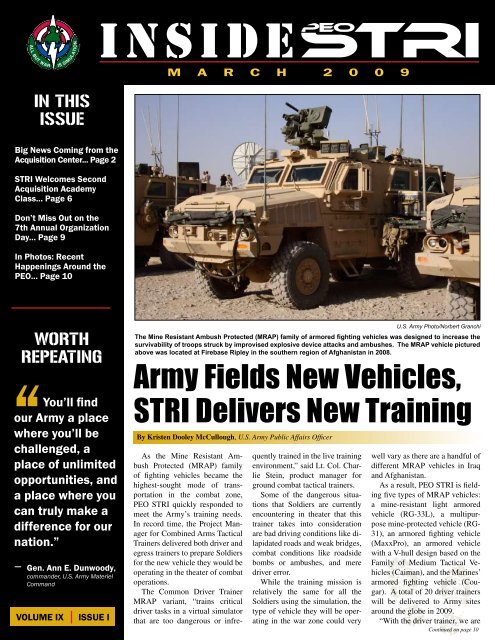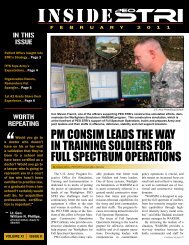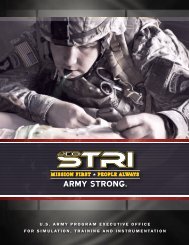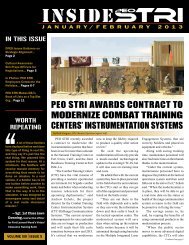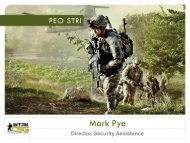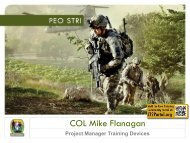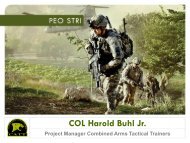inside - PEO STRI - U.S. Army
inside - PEO STRI - U.S. Army
inside - PEO STRI - U.S. Army
Create successful ePaper yourself
Turn your PDF publications into a flip-book with our unique Google optimized e-Paper software.
<strong>inside</strong><br />
m a r c h 2 0 0 9<br />
In this<br />
Issue<br />
Big News Coming from the<br />
Acquisition Center... Page 2<br />
<strong>STRI</strong> Welcomes Second<br />
Acquisition Academy<br />
Class... Page 6<br />
Don’t Miss Out on the<br />
7th Annual Organization<br />
Day... Page 9<br />
In Photos: Recent<br />
Happenings Around the<br />
<strong>PEO</strong>... Page 10<br />
Worth<br />
Repeating<br />
You’ll find<br />
our <strong>Army</strong> a place<br />
where you’ll be<br />
challenged, a<br />
place of unlimited<br />
opportunities, and<br />
a place where you<br />
can truly make a<br />
difference for our<br />
nation.”<br />
Gen. Ann E. Dunwoody,<br />
commander, U.S. <strong>Army</strong> Materiel<br />
Command<br />
VOLUME IX<br />
ISSUE I<br />
U.S. <strong>Army</strong> Photo/Norbert Granchi<br />
The Mine Resistant Ambush Protected (MRAP) family of armored fighting vehicles was designed to increase the<br />
survivability of troops struck by improvised explosive device attacks and ambushes. The MRAP vehicle pictured<br />
above was located at Firebase Ripley in the southern region of Afghanistan in 2008.<br />
<strong>Army</strong> Fields New Vehicles,<br />
<strong>STRI</strong> Delivers New Training<br />
By Kristen Dooley McCullough, U.S. <strong>Army</strong> Public Affairs Officer<br />
As the Mine Resistant Ambush<br />
Protected (MRAP) family<br />
of fighting vehicles became the<br />
highest-sought mode of transportation<br />
in the combat zone,<br />
<strong>PEO</strong> <strong>STRI</strong> quickly responded to<br />
meet the <strong>Army</strong>’s training needs.<br />
In record time, the Project Manager<br />
for Combined Arms Tactical<br />
Trainers delivered both driver and<br />
egress trainers to prepare Soldiers<br />
for the new vehicle they would be<br />
operating in the theater of combat<br />
operations.<br />
The Common Driver Trainer<br />
MRAP variant, “trains critical<br />
driver tasks in a virtual simulator<br />
that are too dangerous or infrequently<br />
trained in the live training<br />
environment,” said Lt. Col. Charlie<br />
Stein, product manager for<br />
ground combat tactical trainers.<br />
Some of the dangerous situations<br />
that Soldiers are currently<br />
encountering in theater that this<br />
trainer takes into consideration<br />
are bad driving conditions like dilapidated<br />
roads and weak bridges,<br />
combat conditions like roadside<br />
bombs or ambushes, and mere<br />
driver error.<br />
While the training mission is<br />
relatively the same for all the<br />
Soldiers using the simulation, the<br />
type of vehicle they will be operating<br />
in the war zone could very<br />
well vary as there are a handful of<br />
different MRAP vehicles in Iraq<br />
and Afghanistan.<br />
As a result, <strong>PEO</strong> <strong>STRI</strong> is fielding<br />
five types of MRAP vehicles:<br />
a mine-resistant light armored<br />
vehicle (RG-33L), a multipurpose<br />
mine-protected vehicle (RG-<br />
31), an armored fighting vehicle<br />
(MaxxPro), an armored vehicle<br />
with a V-hull design based on the<br />
Family of Medium Tactical Vehicles<br />
(Caiman), and the Marines’<br />
armored fighting vehicle (Cougar).<br />
A total of 20 driver trainers<br />
will be delivered to <strong>Army</strong> sites<br />
around the globe in 2009.<br />
“With the driver trainer, we are<br />
Continued on page 10
STOC II Positions peo <strong>STRI</strong><br />
to Better Enable Soldiers<br />
By Kristen Dooley McCullough, <strong>PEO</strong> <strong>STRI</strong> Public Affairs Officer<br />
<strong>PEO</strong> <strong>STRI</strong> granted 142 awards<br />
to more than 120 companies for<br />
the second <strong>STRI</strong> Omnibus Contract,<br />
known as STOC II, early this<br />
year. STOC II, valued at $17.5 billion<br />
over the next 10 years, serves<br />
as an efficient contracting vehicle<br />
in order to quickly get simulation<br />
and training products and services<br />
into the hands of U.S. and coalition<br />
service members.<br />
“STOC II is <strong>PEO</strong> <strong>STRI</strong>’s newest<br />
contract vehicle providing<br />
continued responsiveness to the<br />
Warfighter,” noted John Daniele,<br />
deputy customer support executive<br />
for <strong>PEO</strong> <strong>STRI</strong>. “It is positioned<br />
and structured to meet the<br />
demands of the current and future<br />
operating environments with relevant<br />
and responsive solutions for<br />
the nation.”<br />
Companies competing in<br />
STOC II were evaluated in two<br />
categories: the Full and Open Lot<br />
and the Partial Small Business<br />
Set Aside Lot. Small companies<br />
competing in the Full and Open<br />
Lot also had the opportunity<br />
to compete in the Partial Small<br />
Business Set-Aside Lot, and viceversa.<br />
Two lots were established<br />
in order to enhance <strong>PEO</strong> <strong>STRI</strong>’s<br />
ability to achieve its small business<br />
goals.<br />
In response to the STOC II<br />
Request for Proposal, <strong>PEO</strong> <strong>STRI</strong><br />
evaluated 158 compliant proposals<br />
in which 127 proposals (60 large<br />
companies and 67 small companies)<br />
were entertained in the Full<br />
and Open Lot, and 98 proposals<br />
were assessed in the Partial Small<br />
Business Set-Aside Lot.<br />
The proposals were evaluated<br />
based on four core factors detailed<br />
in the Request for Proposal:<br />
past performance, management,<br />
small business participation plan<br />
(applicable only to the large companies<br />
in the Full and Open Lot)<br />
and cost/price.<br />
“The overall purpose of STOC<br />
II is to have highly-qualified contractors<br />
on-hand to rapidly satisfy<br />
the needs of our nation’s Warfighters,”<br />
explained Brian Murphy,<br />
the <strong>PEO</strong> <strong>STRI</strong> contracting officer<br />
responsible for STOC II.<br />
Existing STOC I contracts—<br />
which were awarded in four different<br />
categories: Live, Virtual,<br />
Constructive and Test-Instrumentation—remain<br />
a viable solution<br />
during the transition period until<br />
each respective domain expires.<br />
The first domain, Test-Instrumentation,<br />
expired late February,<br />
2009. The remaining domains<br />
expire March 2009.<br />
“Leveraging experience with<br />
the STOC I contract, STOC II<br />
accommodates emerging requirements,<br />
technologies and innovation<br />
via access to an extensive<br />
array of industry and academia<br />
capabilities,” Daniele said.<br />
Companies outside of STOC<br />
II will still be able to do business<br />
with <strong>PEO</strong> <strong>STRI</strong>. Murphy advised,<br />
“STOC II is just one tool in<br />
a contracting officer’s toolkit.” <br />
Giunta Named Head<br />
of Acquisition Center<br />
By Kristen Dooley McCullough,<br />
<strong>PEO</strong> <strong>STRI</strong> Public Affairs Officer<br />
<strong>PEO</strong> <strong>STRI</strong> appointed Joe<br />
Giunta the Principal Assistant<br />
Responsible for Contracting<br />
(PARC) March 2009. As the<br />
PARC, he is responsible for<br />
overseeing and leading the<br />
Acquisition Center, which<br />
consists of a group of 130<br />
contracting professionals who<br />
execute a multibillion dollar<br />
portfolio.<br />
In his previous position,<br />
Giunta served as <strong>PEO</strong> <strong>STRI</strong>’s<br />
strategic integrator where he<br />
provided expertise on the organization’s<br />
outreach policies<br />
and procedures. He was responsible<br />
for developing and<br />
executing outreach strategies<br />
that established partnerships<br />
and an increased awareness<br />
and knowledge of the <strong>PEO</strong><br />
product portfolio. Additionally,<br />
he led the integration activities<br />
across the <strong>PEO</strong>’s nonsystem<br />
and system Training<br />
Aids, Devices and Simulation<br />
Systems programs in support<br />
of the <strong>Army</strong> Training Support<br />
System.<br />
In his last military assignment,<br />
Giunta was the product<br />
manager for Ground Combat<br />
Tactical Trainers within <strong>PEO</strong><br />
<strong>STRI</strong>.<br />
Throughout his distinguished<br />
military career, Giunta<br />
served in a variety of contracting<br />
positions. He was the<br />
deputy director for acquisition<br />
and contracting at the Natick<br />
Research, Development and<br />
Engineering Center in Massachusetts.<br />
He later served as the procurement<br />
officer and chief of<br />
the Integration and Support<br />
Division at the Battle Lab Integration,<br />
Technology, and Concepts<br />
Directorate within the<br />
Training and Doctrine Command<br />
at Fort Monroe, Va.<br />
Additionally, Giunta was<br />
previously assigned as the director<br />
of contracting for the<br />
<strong>Army</strong> Central Command in<br />
Kuwait.<br />
He is a member of the <strong>Army</strong><br />
Acquisition Corps and holds<br />
Level III Certifications in both<br />
contracting and program management.<br />
His formal education includes<br />
a bachelor’s degree in<br />
political science from Catawba<br />
College, in Salisbury, N.C.,<br />
and a master’s degree in public<br />
administration from Framingham<br />
State College in Massachusetts.<br />
His civilian and military<br />
education includes the Armor<br />
Officer Basic and Advanced<br />
Courses, Battalion Motor Officer<br />
Course, Mortar Platoon<br />
Leaders Course, Combined<br />
Arms Service Staff School,<br />
the <strong>Army</strong> Command and General<br />
Staff College and the Defense<br />
Systems Management<br />
College, Advanced Program<br />
Managers Course. <br />
2<br />
Inside <strong>STRI</strong> MARCH 2009
PM ITTS’ Target Management<br />
Office Recognized for their<br />
Work in Virtual Targets<br />
By Jed Sheehan, PM ITTS Targets Management Office<br />
The Project Manager for Instrumentation,<br />
Targets and Threat<br />
Simulators’ Targets Management<br />
Office, based out of Huntsville,<br />
Ala., was recently recognized at<br />
the 2009 Modeling and Simulation<br />
Leadership Summit for the<br />
work being done in their Virtual<br />
Targets Center.<br />
The summit was held in conjunction<br />
with the Congressional<br />
Modeling and Simulation Caucus,<br />
in Norfolk, Va. During the<br />
caucus, Dr. Mikel D. Petty, director<br />
for the University of Alabama<br />
in Huntsville’s Center for Modeling,<br />
Simulation, and Analysis,<br />
represented the Alabama Modeling<br />
and Simulation Council.<br />
Petty served as a panelist during<br />
the event and discussed the<br />
southeast and south-central regional<br />
initiatives in modeling<br />
and simulation. Specifically, he<br />
addressed technology, workforce<br />
development, industrial development,<br />
organizational relation,<br />
business practices and economic<br />
impact.<br />
Petty also highlighted virtual<br />
targets during his presentation<br />
because they represent an example<br />
of high-technology deriving<br />
from the southeast and southcentral<br />
area of the U.S.<br />
Much of Petty’s presentation<br />
derived from an Alabama Modeling<br />
and Simulation Council information<br />
paper. The paper specifically<br />
cites the importance of<br />
the Virtual Targets Center:<br />
“Imaginative forms of business<br />
practice are emerging within the<br />
[modeling and simulation] community<br />
of practice wherein cooperation<br />
among industry, government<br />
and academia are significantly<br />
facilitated. For instance,<br />
new and enhanced weapon systems<br />
are often tested with M&S,<br />
using digital<br />
virtual<br />
models of the<br />
targets they<br />
are intended<br />
to engage.<br />
Those target<br />
models must be<br />
detailed, accurate, and authoritative<br />
if the testing that uses<br />
them is to be reliable. The U.S.<br />
<strong>Army</strong> is developing a library of<br />
extremely detailed, highly accurate,<br />
and carefully validated virtual<br />
target models that faithfully<br />
represent those targets in the infrared,<br />
radio frequency, and visual<br />
spectrums and are freely available<br />
to qualified users via an online<br />
accessible repository. Reciprocally,<br />
model contributions can<br />
be contributed by industry or academic<br />
organizations and practitioners<br />
to enrich the collective<br />
information resource. This activity<br />
illustrates the imaginative<br />
business practices that enable<br />
cooperation among government,<br />
industry, and academia to the advantage<br />
of all.”<br />
The Virtual Targets Center,<br />
which is located in the Huntsville,<br />
Ala., area at Redstone Arsenal,<br />
fosters the reuse of validated<br />
simulation target models<br />
by developing a family of simulation<br />
target models. These models<br />
provide users high-quality radar<br />
frequency and infrared analysis<br />
models that can be employed<br />
with confidence into simulations.<br />
The models are easy to obtain<br />
through a web-based distribution<br />
system and are configured to<br />
support a wide range of simulation<br />
types.<br />
For more information on the<br />
Virtual Targets Center, contact<br />
Robbin Finley at 256-842-6459<br />
or robbin.finley@us.army.mil. <br />
GET OUT YOUR HULA gEAR<br />
the next<br />
Town<br />
Hall<br />
Meeting<br />
Is growing near<br />
Show your spirit,<br />
wear tropical attire<br />
to the next<br />
Town Hall Meeting!<br />
Credit: U.S. <strong>Army</strong> Photo/PM ITTS TMO<br />
Project Manager for Instrumentation Targets and Threat<br />
Simulators’ Targets Management Office is supporting<br />
the Office of Secretary of Defense Center for Countermeasures<br />
in development of the Towed Airborne Plume<br />
Simulator (TAPS) program. TAPS is a target towed by<br />
a manned aircraft that is intended to simulate various<br />
threat missiles’ infrared signatures. After its development,<br />
plans call for TAPS to be used for operational testing<br />
of U.S. Air Force Missile Warning Systems in typical<br />
flight environments. The TAPS, pictured above, was being<br />
towed by a Lear 36 aircraft over Gulf Range, Fla., during<br />
airborne infrared characterization and measurement<br />
testing February 2009.<br />
Inside <strong>STRI</strong> MARCH 2009 3
Let’s Talk Finance: Times Are Changin’<br />
From the Desk of John W. Kirch, Chief Financial Manager<br />
During the presidential election<br />
last year, both candidates<br />
adopted a mantra of “Change”<br />
as one of the key planks in their<br />
platforms. This was a clarion<br />
call that there would be a change<br />
in how the Executive Branch of<br />
government would conduct the<br />
business of government, regardless<br />
of who was elected. The<br />
Department of Defense (DoD)<br />
has the largest budget in the Executive<br />
Branch, so it is logical<br />
to expect that DoD would experience<br />
significant change in the<br />
coming years. Additionally,<br />
with the evolving circumstances<br />
in Afghanistan, Iraq, and the<br />
Middle East, along with worldwide<br />
financial instability, a reasonable<br />
assessment may be that<br />
change is already here.<br />
Given the premise that we<br />
are already in a changed world,<br />
with plenty more changes on<br />
the way, now is the time to endeavor<br />
to manage the change.<br />
To successfully manage change,<br />
it is critical to adopt a mindset<br />
that the end result will be better,<br />
despite any daunting immediate<br />
challenges. The DoD will<br />
likely be faced with a reduction<br />
in resources, and since that may<br />
be beyond our control, we need<br />
to see it as an opportunity to<br />
make <strong>PEO</strong> <strong>STRI</strong> and the <strong>Army</strong><br />
better. The following Q&A<br />
with potential questions should<br />
help your program cope if the<br />
Department of Defense experiences<br />
a reduction in resources.<br />
Q: I already have several<br />
unfunded requirements,<br />
and my funding has just<br />
been cut by 30 percent<br />
over the next six years.<br />
Where’s the silver lining<br />
in that dark cloud?<br />
A: This is an opportunity to<br />
terminate some long overdue<br />
programs. For example, it’s<br />
time to get rid of legacy programs<br />
that have been by-passed<br />
by technology or unexecutable<br />
programs that have only maintained<br />
skeleton crews to stay<br />
alive, but haven’t really developed<br />
anything. It’s also a good<br />
time to do away with redundant<br />
systems and programs we wanted<br />
to do away with, but other<br />
stakeholders kept them alive.<br />
It is also an opportunity to rebaseline<br />
programs with immature<br />
technologies so they have<br />
more time to mature. It is also<br />
provides a good justification to<br />
redefine programs that failed to<br />
be everything to everyone. Furthermore,<br />
spiral developments<br />
may be more beneficial in the<br />
long run if more time is allotted<br />
between the updated versions.<br />
Q: We just received notice<br />
that we are getting a 20<br />
percent decrease in authorized<br />
manpower. Show<br />
me a silver lining in that!<br />
tions come along with manpower<br />
reductions, our challenge<br />
is to fit the right number<br />
of people with the right skills<br />
into the programs that survive.<br />
A predictable, beneficial, and<br />
essential by-product of fewer<br />
people is a reduction in the layers<br />
of bureaucracy. This should<br />
improve communication within<br />
an organization and shorten<br />
approval times for everything.<br />
Each individual will most likely<br />
gain more authority, responsibility,<br />
and accountability for<br />
their work.<br />
Often times, in an effort to<br />
avoid reductions in force, the<br />
federal government provides<br />
opportunities to re-train people<br />
for new requirements. This<br />
could serve both the organization<br />
and individuals well.<br />
Q: How are the changing<br />
aspects of the war, DoD’s<br />
funding, and the global<br />
financial crisis going to<br />
affect us at <strong>PEO</strong> <strong>STRI</strong>?<br />
A: One word: Training. With<br />
the potential of many troops<br />
coming home sooner rather than<br />
later, this will lower DoD’s expenses<br />
and could lessen reductions<br />
to acquisition programs.<br />
We have been in somewhat of<br />
a knee-jerk reaction mode<br />
to addressing the latest<br />
threat and getting<br />
a quick fix<br />
out to the field.<br />
We can use this<br />
time to take a<br />
breather and<br />
apply<br />
more en-<br />
during<br />
analyses<br />
a n d<br />
solutions.<br />
The <strong>PEO</strong> S T R I<br />
A: This usually does not result in<br />
reductions in force, but rather it<br />
is most often achieved through<br />
attrition until the authorization<br />
goals are met. It is an optimal<br />
time to evaluate future needs<br />
and restructure your skill sets.<br />
As a matter of course, people<br />
just continue the work they’ve<br />
been doing for years without reassessing<br />
the right size and mix<br />
of an organization. This could<br />
be an opportunity to improve<br />
efficiency.<br />
Assuming the funding reducmotto<br />
says, “All but war is simulation.”<br />
Since fewer of our<br />
troops will be at war, they will<br />
be training.<br />
In summary…<br />
Without a doubt, times are<br />
changing. It is reasonable for<br />
us to forecast that our financial<br />
and human resources to experience<br />
a downward shift. As wise<br />
stewards of our resources, we<br />
should face the new world, embrace<br />
change, and see this as an<br />
opportunity to make <strong>PEO</strong> <strong>STRI</strong><br />
a more effective, efficient, and<br />
vital organization. <br />
4<br />
Inside <strong>STRI</strong> MARCH 2009
<strong>STRI</strong> Takes Serious Gaming to<br />
the Next Level with vbs2<br />
By Kristen Dooley McCullough, <strong>PEO</strong> <strong>STRI</strong> Public Affairs Officer<br />
Soldiers all over the United<br />
States, and even in three locations<br />
abroad, will soon be training<br />
on the <strong>Army</strong>’s newest game,<br />
Virtual Battlespace 2, or VBS2<br />
for short. In fact, Soldiers at<br />
Forts Hood, Texas, Bragg, N.C.,<br />
Carson, Colo., and Lewis, Wash.,<br />
have been among the first groups<br />
to receive the <strong>Army</strong>’s official<br />
game for training since February<br />
2009.<br />
“The <strong>Army</strong> takes gaming technology<br />
seriously because small<br />
unit leaders are highly receptive<br />
to using a technology they have<br />
grown up with. Small units use<br />
games for training to refine decision-making<br />
skills associated<br />
with shoot, move and communicate<br />
collective tasks in a mounted<br />
or dismounted environment,” explained<br />
Lt. Col. Gary Stephens,<br />
product manager for air and command<br />
tactical trainers.<br />
VBS2, the <strong>Army</strong>’s next generation<br />
of games for training,<br />
was procured by <strong>PEO</strong> <strong>STRI</strong> in<br />
response to an operational needs<br />
statement from the U.S. <strong>Army</strong><br />
Forces Command. The contract<br />
was awarded Dec. 19, 2008, to<br />
Laser Shot, Inc., for $17.7 million<br />
over the next five years. In<br />
addition to the contract award for<br />
software, <strong>PEO</strong> <strong>STRI</strong> awarded a<br />
$6 million contract to CDW-G<br />
for the actual computers.<br />
From February to September<br />
2009, <strong>PEO</strong> <strong>STRI</strong> will field 70<br />
training systems to 53 locations<br />
across the continental United<br />
States, Germany, Italy and South<br />
Korea. Each system consists<br />
of 52 laptop computers and the<br />
associated peripheral gaming<br />
equipment.<br />
“In VBS2, Soldiers are able to<br />
operate vehicles, fire weapons,<br />
pilot unmanned aerial vehicles<br />
and do most anything a Soldier<br />
does in a high-fidelity synthetic<br />
environment,” said Leslie<br />
Dubow, project director for gaming<br />
at <strong>PEO</strong> <strong>STRI</strong>.<br />
Previous to VBS2, <strong>PEO</strong> <strong>STRI</strong><br />
fielded the original game for<br />
training Soldiers, DARWARS<br />
Ambush!. The effort fielded<br />
3,000 copies of the game to the<br />
<strong>Army</strong>, Navy, Air Force, Marines,<br />
Coast Guard and Department of<br />
Homeland Defense since 2006.<br />
Much like DARWARS Ambush!,<br />
VBS2 is a first-person<br />
shooter game that portrays a realistic<br />
operational environment.<br />
In addition, both games offer an<br />
after action review capability.<br />
The new game, however, has<br />
significant improvements over<br />
its predecessor. First, the geographical<br />
terrain database has increased<br />
from 13 kilometers by 13<br />
kilometers to 100 kilometers by<br />
100 kilometers. “The larger geographical<br />
space better represents<br />
the current operational environment,”<br />
Stephens said.<br />
Secondly, VBS2 offers a threedimensional<br />
mission editor that<br />
allows users to make changes to<br />
the training scenario in real time.<br />
Additionally, a more user-friendly<br />
mission editor permits users to<br />
easily create training scenarios<br />
that are designated to meet training<br />
objectives.<br />
Furthermore, the new game<br />
includes a Distributed Interactive<br />
Simulation-High Level Architecture<br />
interface that allows the<br />
system to interoperate with other<br />
virtual, constructive and battle<br />
command systems.<br />
While <strong>PEO</strong> <strong>STRI</strong> is responsible<br />
for acquiring and fielding the<br />
game, the Training and Doctrine<br />
Command Training Capabilities<br />
Manager for Gaming is responsi-<br />
ble for determining requirements<br />
and what skills Soldiers should<br />
learn from the game.<br />
The game replicates what Soldiers<br />
encounter on today’s battlefield<br />
so that users can practice<br />
a multitude of kinetic and non-<br />
U.S. <strong>Army</strong> Photo/Training and Doctrine Command<br />
<strong>PEO</strong> <strong>STRI</strong> began fielding Virtual Battlespace 2, the <strong>Army</strong>’s newest<br />
computer-based game for training, February 2008. The game replicates<br />
the environment that Soldiers are facing on today’s battlefield.<br />
kinetic skills—everything from<br />
operating in an urban terrain and<br />
reacting to ambush operations to<br />
cultural and language awareness,<br />
explained Col. Mark McManigal,<br />
the TRADOC capabilities manager<br />
for gaming. <br />
Did You know?<br />
One of the <strong>Army</strong>’s new field manuals, Training<br />
for Full Spectrum Operations, states that<br />
gaming is the use of technology employing<br />
commercial or government off-the-shelf,<br />
multi-genre games in a realistic, semiimmersive<br />
environment to support education<br />
and training. Although the <strong>Army</strong> has used<br />
games informally for many years, it had never<br />
established a formal sustainable program for<br />
the acquisition and use of games until April<br />
2008. VBS2 was developed as the first official<br />
<strong>Army</strong> game to train and educate Soldiers,<br />
leaders and organizations.<br />
Inside <strong>STRI</strong> MARCH 2009 5
peo <strong>STRI</strong> Welcomes<br />
Another Acquisition<br />
Academy Class<br />
By Kristen Dooley McCullough, <strong>PEO</strong> <strong>STRI</strong> Public Affairs Officer<br />
The second Acquisition<br />
Academy class, consisting of 18<br />
<strong>Army</strong> interns, kicked-off March<br />
2, 2009. Different from the first<br />
class that focused mainly on<br />
contracting skill sets, this time<br />
coursework covers an array of<br />
acquisition-related career fields.<br />
As such, each of the interns was<br />
hired into a specific career path,<br />
namely engineering, budget and<br />
program analysis, acquisition<br />
logistics, program management<br />
and contracting.<br />
“For the second class, we<br />
wanted to create an integrated<br />
product team environment,”<br />
said Jean Burmester, dean of the<br />
Acquisition Academy. “With<br />
the multiple career programs<br />
integrated into one class, the<br />
interns will experience a typical<br />
work environment where many<br />
different people representing<br />
various functional areas work<br />
together on a program.”<br />
The class—comprised of two<br />
project directors, three program<br />
analysts, a logistics management<br />
specialist, two budget analysts,<br />
six contract specialists and four<br />
engineers—is learning about<br />
their functional areas by studying<br />
an actual <strong>PEO</strong> <strong>STRI</strong> program:<br />
the Multiple Integrated Laser<br />
Engagement System.<br />
In addition to the careerspecific<br />
work, the interns will<br />
accomplish a multitude of<br />
administrative tasks during<br />
the 11-week multidisciplinary<br />
program. They have applied for<br />
and received security clearances,<br />
e-mail accounts and identification<br />
badges.<br />
Interns will also learn important<br />
information about federal<br />
employment, like government<br />
benefits, how to correctly<br />
report time and attendance, and<br />
how to use the Defense Travel<br />
System. They will receive ethics<br />
training, an orientation from their<br />
functional career representative<br />
and information on the National<br />
Security Personnel System.<br />
Furthermore, the interns<br />
will become familiar with the<br />
<strong>PEO</strong> <strong>STRI</strong> mission, its strategic<br />
plan and the role of each of the<br />
project managers. They will be<br />
taught about <strong>Army</strong> organizations,<br />
installations, ranks and how the<br />
<strong>Army</strong> is structured.<br />
“During the course, the class<br />
will travel to a nearby <strong>Army</strong><br />
installation to see how Soldiers<br />
live and train,” Burmester noted.<br />
“The interns will even see many of<br />
the training products and services<br />
they will be supporting at <strong>PEO</strong><br />
<strong>STRI</strong>.”<br />
Upon the completion of the<br />
course, Burmester said success will<br />
be defined not only by attracting,<br />
but more importantly, retaining<br />
the new federal employees that,<br />
through the Academy, will have<br />
the essential knowledge and<br />
skills necessary for successful<br />
acquisition management at <strong>PEO</strong><br />
<strong>STRI</strong>.<br />
“Ensuring interns are provided<br />
the appropriate acquisition and<br />
functional requirements will go a<br />
long way in enabling <strong>PEO</strong> <strong>STRI</strong> to<br />
meet the Warfighters’ vital mission<br />
requirements,” Burmester noted. <br />
Jean Burmester, Dean<br />
Hometown: San Jose, Ca.<br />
Education: B.S., Rollins College, and<br />
M.B.A., Florida Institute of Technology<br />
Work experience:Director, ADL Co-<br />
Lab; senior project director, AVCATT<br />
“Ensuring<br />
interns are<br />
provided the<br />
appropriate<br />
acquisition<br />
and functional<br />
requirements<br />
will go a long<br />
way in enabling<br />
<strong>PEO</strong> <strong>STRI</strong><br />
to meet the<br />
Warfighters’<br />
vital mission<br />
requirements.”<br />
Jean Burmester<br />
Dean, Acquisition Acedemy<br />
Hugo Carneiro<br />
Hometown: Oviedo, Fla.<br />
Education: Mechanical Engineering,<br />
University of Central Florida<br />
Work experience: Refrigeration<br />
technician<br />
William “Bill” Leeman<br />
Hometown: Fort Myers, Fla.<br />
Education: B.S. in finance, and<br />
working on an M.B.A., both from<br />
University of Central Florida<br />
Work experience: Personal finance;<br />
commercial banking<br />
Dan Santiago<br />
Hometown: Jersey City, N.J.<br />
Education: B.S. in technical and operational<br />
education, University of Southern<br />
Mississippi; M.S. in computing<br />
Work experience: U.S. Air Force, <strong>PEO</strong><br />
<strong>STRI</strong> Chief Information Office<br />
6<br />
Inside <strong>STRI</strong> MARCH 2009
Kerry Connors<br />
Hometown: Hingham, Mass.<br />
Education: M.A. in finance,<br />
Webster University<br />
Work experience: U.S. Air Force;<br />
stockbroker; mortgage broker<br />
Jesse Del Rio<br />
Hometown: Carolina, Puerto Rico<br />
Education: B.S. in finance, University<br />
of Central Florida<br />
Work experience: Intern, Orlando<br />
Health; intern, Smith Barney<br />
Jason Holden<br />
Hometown: Grand Rapids, Minn.<br />
Education: B.A. in legal studies,<br />
University of Central Florida<br />
Work experience: Site acquisition;<br />
project coordinator<br />
William “Billy” Jensen<br />
Hometown: Navarre, Fla.<br />
Education: B.S. in business marketing,<br />
University of Central Florida<br />
Work experience: Personal banking<br />
Aderian Kirk<br />
Hometown: Miami, Fla.<br />
Education: B.S. in accounting,<br />
University of Central Florida<br />
Work experience: Banking;<br />
financial services; sales<br />
Theodore “Ted” Lujan<br />
Hometown: Santa Rosa, Ca.<br />
Education: B.A. in justice administration,<br />
Hawaii Pacific University<br />
Work experience: U.S. <strong>Army</strong>;<br />
pharmaceutical sales; business sales<br />
Tinisha McCurdie<br />
Hometown: Miami, Fla.<br />
Education: B.S. in finance and real<br />
estate, University of Central Florida<br />
Work experience: Web and graphic<br />
design<br />
Ann Pham<br />
Hometown: Saigon, Vietnam<br />
Education: M.B.A., Webster<br />
University<br />
Work experience: Software<br />
development; banking<br />
Carrie Pickett<br />
Hometown: Longwood, Fla.<br />
Education: B.S. in legal studies,<br />
University of Central Florida<br />
Work experience: Senior paralegal,<br />
Holihan Law<br />
Matt Sanders<br />
Hometown: Tampa, Fla.<br />
Education: B.S. in business<br />
administration<br />
Work experience: Small business<br />
owner, Guam Contract Dive Services<br />
John H. Smith III<br />
Hometown: Columbus, Miss.<br />
Education: M.B.A., University of<br />
Central Florida<br />
Work experience: Land development<br />
manager<br />
Wallace Tennille<br />
Hometown: Patmos, Ga.<br />
Education: B.S. in computer<br />
engineering; M.S. in electrical and<br />
computer engineering, both from<br />
Georgia Tech University<br />
Work experience: Intern, HD Supply<br />
Thomas Torres<br />
Hometown: Orlando, Fla.<br />
Education: B.S. in electrical engineering,<br />
University of Central Florida<br />
Work experience: Best Buy<br />
Dan Veenstru<br />
Hometown: Largo, Fla.<br />
Education: B.S. in business<br />
administration; M.B.A., both from<br />
University of Central Florida<br />
Work experience: Product<br />
development manager, TouricoHolidays<br />
Chester Williams<br />
Hometown: Umatilla, Fla.<br />
Education: B.S. in electrical<br />
engineering<br />
Work experience: Engineering and<br />
management<br />
Inside <strong>STRI</strong> MARCH 2009 7
<strong>PEO</strong> <strong>STRI</strong>, Industry Strategic Partnering Forum<br />
By Linda Achee, Principal Consultant to <strong>PEO</strong> <strong>STRI</strong><br />
<strong>PEO</strong> <strong>STRI</strong> will soon host its first<br />
Strategic Partnering Forum with<br />
industry in the late-Spring, early-<br />
Summer of 2009. The forum’s<br />
purpose is to share <strong>PEO</strong> <strong>STRI</strong>’s<br />
strategic intent with industry<br />
while fostering a reciprocal<br />
environment in which industry<br />
shares their thoughts on strategic<br />
objectives in order to achieve the<br />
<strong>PEO</strong>’s vision and mission.<br />
Participants in the forum will<br />
be selected from the total industry<br />
pool with the intent of having<br />
representation from large, small,<br />
new and established industry<br />
partners. Participants will be<br />
selected randomly and different<br />
participants will be selected for<br />
each successive forum session.<br />
<strong>PEO</strong> <strong>STRI</strong> and industry will<br />
discuss ideas and provide feedback<br />
as to how they are strategically<br />
aligned to support the Warfighter.<br />
The forum’s goal is to achieve<br />
mutually beneficial strategic<br />
outcomes through collaboration.<br />
The forum is intended to<br />
facilitate the exchange of ideas,<br />
suggestions, recommendations<br />
and “roll up your sleeve” kinds<br />
of discussions that assist both<br />
industry and the <strong>PEO</strong> in efforts<br />
to define the initiatives that allow<br />
the community to move toward<br />
strategic objectives. <br />
Team Orlando at Work: <strong>Army</strong> and USMC Move<br />
toward Common Live Training Solutions<br />
By William Samper, Lead Engineer in Project Manager Training Devices<br />
The <strong>Army</strong>’s Project Manager<br />
Training Devices (PM TRADE)<br />
and the Marine Corps’ Assistant<br />
Program Manager Training<br />
Systems – Live (PM TRASYS<br />
APM-Live) signed an agreement<br />
to establish a Live Training Transformation<br />
(LT2) product line<br />
partnership to support the Marine<br />
Corps’ range modernization and<br />
transformation programs.<br />
The goal of the partnership<br />
is to promote interoperability<br />
and maximize the reusability of<br />
existing LT2 product line components<br />
to reduce acquisition<br />
costs and risks associated with<br />
PM TRASYS’ range instrumentation<br />
systems.<br />
The Program Level Agreement,<br />
or PLA, establishes PM TRASYS<br />
as a major stakeholder in the LT2<br />
strategy to develop a live training<br />
range product line centered on<br />
common architectures and standards<br />
evolution. PM TRASYS<br />
will use the Common Training<br />
Instrumentation Architecture in<br />
the development of their range<br />
modernization and transformation<br />
programs.<br />
The first LT2 delivery of Marine<br />
Corps Instrumentation Training<br />
System (MC-ITS) is going to<br />
8<br />
Inside <strong>STRI</strong> MARCH 2009<br />
the 29 Palms site this year. The<br />
MC-ITS program will provide<br />
the basis for extending LT2 reuse<br />
to other Marine live training<br />
programs. It will extend the current<br />
capabilities to the future LT2<br />
Consolidated Product Line Management<br />
strategy that will combine<br />
product line development<br />
and sustainment efforts for the<br />
LT2 Family of Training Systems<br />
(LT2-FTS).<br />
The LT2 standardization efforts<br />
and Consolidated Product<br />
Line Management strategy will<br />
provide the following benefits to<br />
both organizations:<br />
• Single management mechanism<br />
to consolidate all LT2-FTS<br />
sustainment and enhancement development<br />
efforts; a common live<br />
training solutions that lowers the<br />
total ownership life cycle costs<br />
across programs while mitigating<br />
potential cost, schedule and performance<br />
risks.<br />
• Consolidation of test resources<br />
reduces overhead, integration<br />
and test costs, and cuts information<br />
assurance management<br />
and certification costs across LT2-<br />
FTS; reduces configuration and<br />
inventory management costs and<br />
provides for help desk support.<br />
• Quality of service and products<br />
are increased through testing<br />
and resolving issues one time<br />
while deploying common solutions<br />
to all programs and training<br />
sites.<br />
• Government and industry<br />
work together to establish interoperability<br />
and technology insertion<br />
standards that foster government<br />
product line evolution and simplify<br />
acquisition processes while<br />
allowing industry to maintain<br />
its competitive edge or business<br />
model.<br />
With this approach, PM TRADE<br />
and PM TRASYS will use a collaborative<br />
integrated product<br />
team mechanism for coordinating<br />
all funding, contractual, technical,<br />
and management matters as<br />
related to the development efforts<br />
between the organizations. This<br />
allows for a bi-directional product<br />
visibility at the appropriate<br />
levels. Together both organizations<br />
will work to identify common<br />
enhancement opportunities<br />
that can be shared across LT2<br />
products benefiting <strong>Army</strong> and<br />
Marine Corps future live training<br />
environments. <br />
U.S. <strong>Army</strong> Photo<br />
Col. Fred Mullins (left), PM TRADE project manager, and Brad Valdyke, PM<br />
TRASYS assistant program manager for live training systems, signed an<br />
agreement Nov. 28, 2009, to promote commonality among the <strong>Army</strong> and<br />
Marine Corps’ live training programs.
Inside <strong>STRI</strong> MARCH 2009 9
MRAP... continued from cover<br />
TEAM ORLANDO IN PICTURES<br />
U.S. <strong>Army</strong> Photo/Doug Schaub<br />
The <strong>Army</strong> <strong>PEO</strong> <strong>STRI</strong> team overwhelmingly defeated the Naval Air<br />
Warfare Center Training Systems Division team 60-19 at the University<br />
of Central Florida gymnasium March 12. The back row<br />
from left to right: Rob Reyenga, Phil Davis, Matt Burris (Air Force<br />
Agency for Modeling and Simulation), Scott Welcheck, Herbert<br />
McDuffie, Roger Hamilton, and Tony Tolbert. Pictured in the front<br />
row from left to right: Shi Deng and Brian Serra.<br />
U.S. <strong>Army</strong> Photo/Doug Schaub<br />
<strong>PEO</strong> <strong>STRI</strong> participated in the Defense GameTech User’s Conference<br />
March 9-11, in Orlando, Fla. Government, industry and academia<br />
gaming experts discussed the current and future state of<br />
gaming technologies and virtual worlds that train Warfighters.<br />
Maj. Gen. Jason Kamiya from the U.S. Joint Forces Command<br />
provided the keynote address. As pictured above, both Kamiya<br />
himself and his virtual avatar briefed the audience. Those attendees<br />
unable to attend the conference in person were able to<br />
participate in the virtual world of Second Life.<br />
U.S. <strong>Army</strong> Photo/Doug Schaub<br />
The Acquisition Academy participated in the University of Central<br />
Florida Challenge Course March 6. The outdoor adventure<br />
is offered through UCF’s Recreation and Wellness Center. The<br />
half-day event consisted of eleven different elements focused on<br />
enhancing group cohesion, communication, and leadership. It<br />
challenged participants mentally and physically as they planned<br />
and executed solutions to different obstacles.<br />
focusing on the fidelity of the<br />
vehicle and its dynamics—the<br />
point at which the vehicle will<br />
rollover,” Stein explained. “To<br />
accurately do this, we’ve worked<br />
with the subject matter experts in<br />
this field: equipment manufacturers<br />
and Soldiers who’ve operated<br />
an MRAP in theater.”<br />
The CDT-MRAP variant is<br />
based on <strong>PEO</strong> <strong>STRI</strong>’s original<br />
driver trainer for the Stryker vehicle<br />
and the follow-on improvements<br />
made with the tank variant.<br />
“It was beneficial to model<br />
the new MRAP driver trainers<br />
on previous driver trainers because<br />
we were able leverage the<br />
same motion base and instructor<br />
stations on the Stryker and tank<br />
variants,” Stein said.<br />
“This gives units the flexibility<br />
to change cabs and train on the<br />
MRAP, Stryker, tank, and some<br />
day in the near future, a tactical<br />
wheeled vehicle,” he noted.<br />
Much like the Stryker and tank<br />
driver trainers, the MRAP trainer<br />
also includes a motion platform,<br />
image generators, an instructor/<br />
operator station and an after action<br />
review station. Most importantly,<br />
the CDT family of driving<br />
simulations is modular, interchangeable<br />
and allows multiple<br />
variants to be compatible with<br />
the common training platform.<br />
“All these qualities are important<br />
because they contribute<br />
to maintainability, sustainability<br />
and a cost-avoidance<br />
to the <strong>Army</strong>,” Stein<br />
said.<br />
In addition to the<br />
driver trainer, <strong>PEO</strong><br />
<strong>STRI</strong> is also fielding<br />
an MRAP egress<br />
trainer in response to<br />
an urgent operational<br />
needs statement<br />
from Iraq. Nearly 30<br />
egress trainers will<br />
be fielded within the<br />
coming months.<br />
The MRAP egress<br />
trainer is modeled on<br />
<strong>PEO</strong> <strong>STRI</strong>’s High<br />
Mobility Multipurpose Wheeled<br />
Vehicle Egress Assistance Trainer,<br />
and much like its predecessor,<br />
the “MRAP trainer proves to<br />
be an <strong>Army</strong> solution to an <strong>Army</strong><br />
problem,” noted Dr. James Blake,<br />
program executive officer for<br />
<strong>PEO</strong> <strong>STRI</strong>.<br />
Many organizations within<br />
the <strong>Army</strong> came together to make<br />
both egress trainers a reality. The<br />
Tank-Automotive Research, Development<br />
and Engineering Center<br />
designed and built the prototype.<br />
This effort was funded by<br />
the <strong>Army</strong> and the Marines’ joint<br />
office, Program Manager MRAP.<br />
Once the prototype was certified<br />
for safety, the Red River<br />
<strong>Army</strong> Depot began production<br />
of the trainers based on the prototype.<br />
Finally, <strong>PEO</strong> <strong>STRI</strong> is responsible<br />
for getting the device into the<br />
hands of the Warfighters in which<br />
the initial fielding schedule calls<br />
for 25 egress trainers to go to the<br />
<strong>Army</strong> in the theater of combat operations.<br />
Additionally, three devices<br />
will go to the Marines.<br />
“Without a doubt, MRAP driver<br />
and egress trainers are important<br />
because many of the Soldiers<br />
and Marines driving MRAP vehicles<br />
down range won’t get the<br />
opportunity to operate these vehicle<br />
until they’re in the theater of<br />
combat operations. We are giving<br />
our Warfighters the opportunity to<br />
train prior to getting in the seat,”<br />
Stein said. <br />
U.S. <strong>Army</strong> Photo<br />
<strong>PEO</strong> <strong>STRI</strong>’s MRAP Egress Assistance Trainer provides Soldiers the<br />
opportunity to experience a simulated rollover in order to learn the proper<br />
tactics and techniques to safely get out of the vehicle. The trainer prepares<br />
Soldiers for the event of an actual vehicle rollover in the combat zone.<br />
10<br />
Inside <strong>STRI</strong> MARCH 2009
HOLIDAYS<br />
Events<br />
April 2<br />
PMT 352B Graduation Ceremony<br />
April 3<br />
Colors<br />
April 15<br />
Barber shop Opens in de Florez<br />
April 17<br />
Leadership Development Seminar<br />
April 22<br />
Administrative Professionals’ Day<br />
April 22<br />
Earth Day<br />
April 22<br />
Jeans Day<br />
Tip of the Month<br />
By Marge Hadbavny, Protocol Officer<br />
Internet Safety Tips for Parents<br />
Although technological advances are<br />
helping to bring people together, they<br />
also are causing new problems for<br />
parents. Here are some points to help<br />
keep your kids safe.<br />
- Talk to your kids about what they are<br />
doing in cyberspace.<br />
- Know with whom your kids are<br />
communicating.<br />
- Consider limitations on electronic<br />
communication.<br />
- Be aware of what your kids are posting<br />
publicly.<br />
- Make sure you are clear about what<br />
you consider appropriate electronic<br />
behavior.<br />
- Remember anything you send or post<br />
in cyberspace will never truly go away.<br />
A Question for the Acquisition Academy Interns...<br />
“What do you hope to accomplish<br />
while at the Academy?”<br />
“I plan to complete all the requirements, become an efficient<br />
project director and be open to the many opportunities<br />
available at <strong>PEO</strong> <strong>STRI</strong>.”<br />
Kerry Connors<br />
U.S. <strong>Army</strong> Photo/Doug Schaub<br />
“I hope to learn more about the organization, what<br />
the various PM Shops do and how my role can make a<br />
difference for the Warfighter.”<br />
Aderian Kirk<br />
U.S. <strong>Army</strong> Photo/Doug Schaub<br />
“I intend to acquire as much knowledge as possible so<br />
that I can jump into the <strong>STRI</strong> workforce and contribute to<br />
my team’s success.”<br />
Ted Lujan<br />
U.S. <strong>Army</strong> Photo/Doug Schaub<br />
“I hope to be recognized as a finance professional with<br />
broad acquisition knowledge and outstanding business<br />
acumen.”<br />
Tinisha McCurdie<br />
U.S. <strong>Army</strong> Photo/Doug Schaub<br />
Want your opinion heard? Answer April’s Question! This question is open to the entire workforce!<br />
Earth Day is April 22; what are you doing to make this world greener? Send your response to<br />
Kristen.Dooley@us.army.mil and put Citizen <strong>STRI</strong> in the subject line.<br />
Inside <strong>STRI</strong> MARCH 2009 11
Do you travel on official duty?<br />
Don’t forget to use City Pair<br />
Travelers are required to book their airfare through City Pair. There are a<br />
few exceptions when travelers do not need to use City Pair (for example,<br />
the flight does not get the passenger to his or her destination in time, or<br />
there are no City Fair flights to the traveler’s destination). If a non-City<br />
Pair flight is booked, travelers are responsible for ensuring appropriate<br />
justifications are entered into the Defense Travel System authorization.<br />
For more information on City Pair,<br />
reference the Travel tab on <strong>PEO</strong> <strong>STRI</strong>’s knowledge Center.<br />
Hails<br />
Michel Berry<br />
PSG<br />
Stephen Bushway<br />
PM ConSim<br />
Cameron Clarke<br />
PSG<br />
Joseph Danet-Molina<br />
PSG<br />
Juan Garcia<br />
PSG<br />
Bridgette Graham<br />
Acq. Center<br />
Stephanie Johnson<br />
PSG<br />
Patrick Lloyd<br />
PSG<br />
Joe Moreira<br />
PM Field OPS<br />
Richard Parrott<br />
PSG<br />
Eugene Phillips<br />
PM TRADE<br />
Nancy Rallis<br />
PM TRADE<br />
Clarebelo Reynoso<br />
PSG<br />
Cicely Simmons<br />
Acq. Center<br />
Susan Stauffer<br />
Acq. Center<br />
Don Stewart<br />
PM ConSim<br />
Mary Vick<br />
PSG<br />
William Vincent<br />
Acq. Center<br />
Farewells<br />
Betty Carden<br />
PM ITTS<br />
Aida Caron<br />
PM ITTS<br />
Wynema Coffey<br />
PM ITTS<br />
Ilene Crapps<br />
Acq. Center<br />
Janine Daniels<br />
<strong>PEO</strong> Staff<br />
Tony Giannoni<br />
PM ITTS<br />
Jeffrey Iddins<br />
PM Field OPS<br />
Sharon McLaughlin<br />
Acq. Center<br />
Mary Truesdell<br />
PSG<br />
Get your blue jeans ready!<br />
Jeans Day will be held April 22, 2009.<br />
As the name implies, this is the one day set aside every year when all<br />
employees are encouraged to come to work in blue jeans and clean<br />
their offices, files and storage areas. Employees are encouraged<br />
to recycle and dispose of unused materials in their assigned<br />
office space. Collection stations will be set up on each floor of<br />
every building. There will be a monitor at each station who will<br />
provide boxes and labels, answer general questions, and inspect<br />
material being dropped off to ensure it can be properly disposed<br />
of. Collection stations will contain recycling bins, disposal areas<br />
for office supplies and areas to drop off surplus office furniture.<br />
Look out for more information on Jeans Day.<br />
Inside<br />
Inside <strong>STRI</strong> is an authorized publication for<br />
military and civilian members of the U.S. <strong>Army</strong><br />
Program Executive Office for Simulation, Training<br />
and Instrumentation, Orlando, Fla. 32826. Inside<br />
<strong>STRI</strong> is published under the authority of AR 360-1<br />
and applies the Associated Press Stylebook industry<br />
standard.<br />
Contents of Inside <strong>STRI</strong> are not necessarily<br />
the official views of, or endorsed by, the U.S.<br />
Government, Department of Defense, Department<br />
of the <strong>Army</strong>, or <strong>PEO</strong> <strong>STRI</strong>.<br />
Editorial material for publication should be<br />
submitted to <strong>PEO</strong> <strong>STRI</strong> Public Affairs Office, 12350<br />
Research Parkway, Orlando, Fla. 32826. The PAO<br />
reserves the right to edit all material submitted for<br />
publication.<br />
For more information about <strong>PEO</strong> <strong>STRI</strong> or to<br />
view Inside <strong>STRI</strong> online, visit our Web site at www.<br />
peostri.army.mil<br />
Editor:<br />
Kristen Dooley McCullough<br />
Editor-in-Chief<br />
kristen.dooley@us.army.mil<br />
Design:<br />
Dwain Fletcher Co.<br />
CGgraphics@us.army.mil<br />
12<br />
Inside <strong>STRI</strong> MARCH 2009


